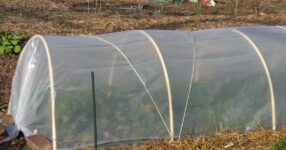
When cold temperatures and frost are in the forecast, low tunnels are one option for gardeners to consider for protecting plants and extending the growing season. (photo courtesy of the UVM Extension Community Horticulture program)
We’ve probably all run out to the garden on a fall evening as the temperature drops and a frost warning is issued. We throw a sheet over our fruit-covered tomato plants to eek just a little more growing time from the rapidly evaporating season. Ghostly visions of sheet-covered tomato plants aside, there are other ways to prolong the harvest.
Once you’ve determined your average first frost date, look around your garden. What plants are still productive? Those growing in pots can be moved inside a greenhouse or into an enclosed porch for protection from the cold.
For in-ground plants, there are several alternatives to extend the growing season. There is, of course, the tried-and-true covering of plants like tomatoes with old sheets or blankets when frost is forecast. Be sure to cover completely to prevent damage to foliage and fruit. Remove the covering in the morning to allow access to the sun’s warmth and light.
A convenient alternative, if you have one handy, is to invert a cardboard box over smaller plants, completely covering them, with the open end of the box resting on the ground. This creates a protective structure around the plant that is easily removed in the morning.
Tomato cages can be encircled with clear plastic. Drive stakes into the ground just outside the plant’s perimeter and wrap plastic around the stakes and over the top, enclosing the plant without touching the foliage. Allow a place that can be opened during the day to vent excess heat.
If you’d rather not build a tomato cover, there are pop-up plastic plant covers available for purchase online or at garden supply stores.
To protect multiple low-growing plants, try floating row covers. Place a length of garden fabric over plants to protect against the cold. Hold edges in place with garden staples or weights. Remove the cover during warm days.
Garden fabric is made of spun-bonded polyester. It allows light and water to penetrate and comes in various weights. Choose a heavier weight to insulate against the cold. As temperatures drop further, plastic sheeting can be added on top of the garden fabric, adding additional insulation.
For taller plants, consider using low tunnels. They function like floating row covers, but with a series of inverted u-shaped supports raising the fabric above the plants. At the end of the row, the fabric drapes to the ground, closing the tunnel. To prevent over-heating on warm days, the ends can be opened, and then closed again as the temperature drops.
If you’re growing cold-hardy varieties of salad greens (kale, Swiss chard, spinach) or root crops (carrots, beets) in a raised bed, you can add a cold frame to extend the harvest season further into the fall.
A cold frame is a box with a transparent cover, hinged so that it can be opened as needed to vent excess heat. At night, the closed cover protects plants. For best results, it should be in a south-facing location in direct sunlight.
Even cold-hardy varieties won’t continue to grow once temperatures drop. They’ll eventually go dormant, but you can still harvest leaves and roots for a time.
These techniques can be used again in the spring to jump start your gardening year.




